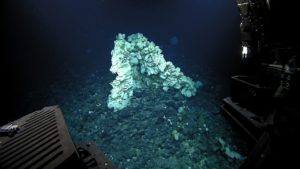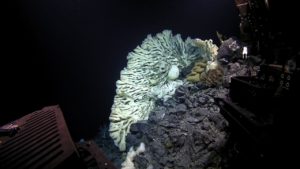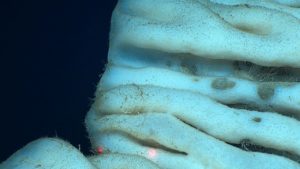Recently a team of scientists on a deep sea expedition in the Northwestern Hawaiian Islands aboard the R/V Okeanos Explorer made a monumental discovery… pun intended. While exploring the depths of the seafloor in Papahānaumokuākea Marine National Monument, with their remotely operated vehicles (ROV) Seirios and Deep Discover, they discovered and documented the largest sponge ever observed on this planet… or any planet for that matter.


(Photo credit: NOAA’s Office of Exploration and Research)
The sponge was determined to be over 3.5 m in length, 2.0 m in width and 1.5 m in height (or roughly the size of a mini-van), exceeding the dimensions of the largest sponge previously known, which was found in shallow waters (<25 m) off western Canada. This rare sponge, with a bluish-white color and brain-like appearance, was found 2100 m (roughly 1.5 miles) below the sea surface, and stunned scientists with its size when it appeared in the remote cameras attached to their underwater rovers.

(Photo credit: NOAA’s Office of Exploration and Research)
While not much is known about the lifespan of sponges, some massive species found in shallow waters are estimated to live for more than 2300 years, leading the researchers on this project to wonder just how old some of these undiscovered deep sea organisms can be. The discovery of this enormous old sponge, underscores the importance of marine sanctuaries for preservation, and the necessity of both deep sea exploration and conservation. Several marine sponges are known to attain massive sizes (though as it currently stands this sponge is the largest), and are critical for ocean health through their ability to filter large amounts of seawater, and provide critical habitat for other sea life (similar to coral reefs).
This is a cool and important finding for deep sea conservation and ecology. You can read the original article published in Marine Biodiversity.